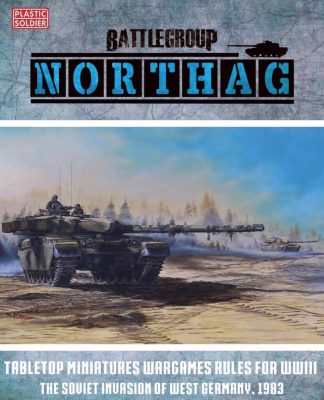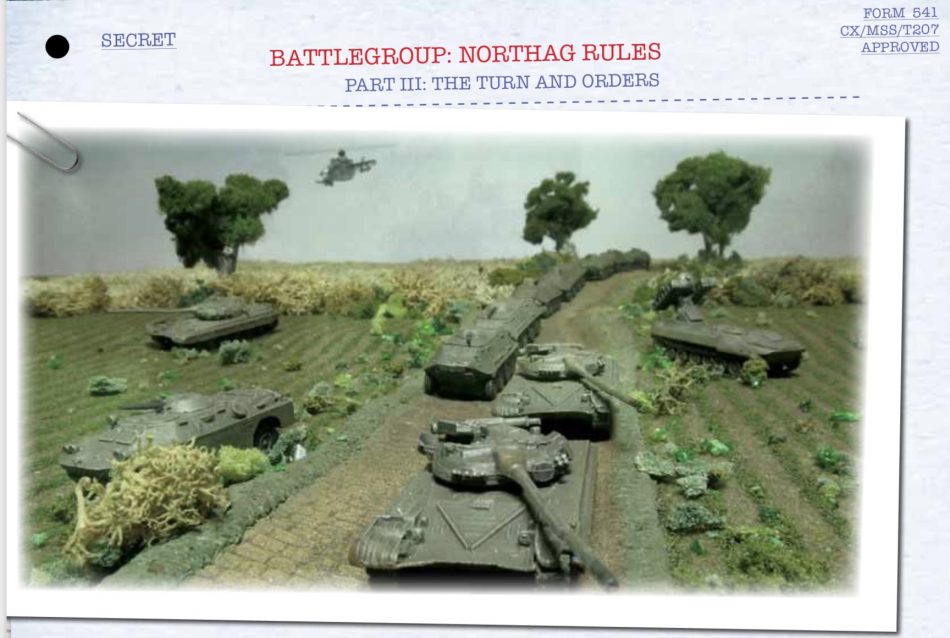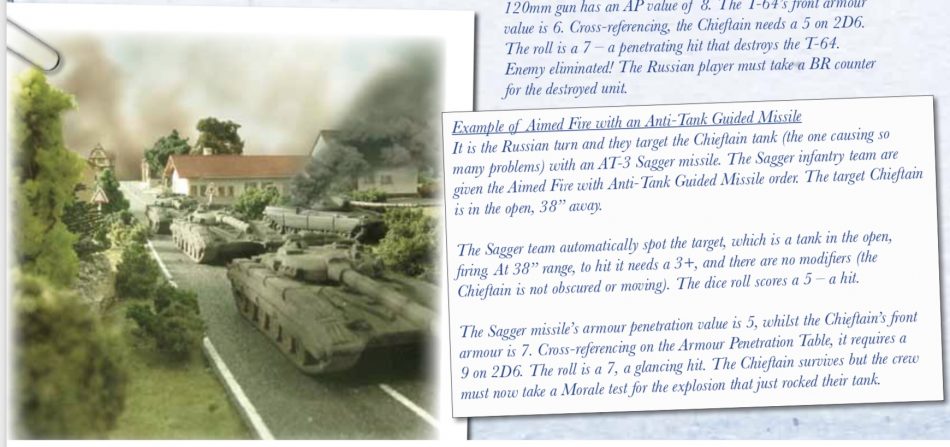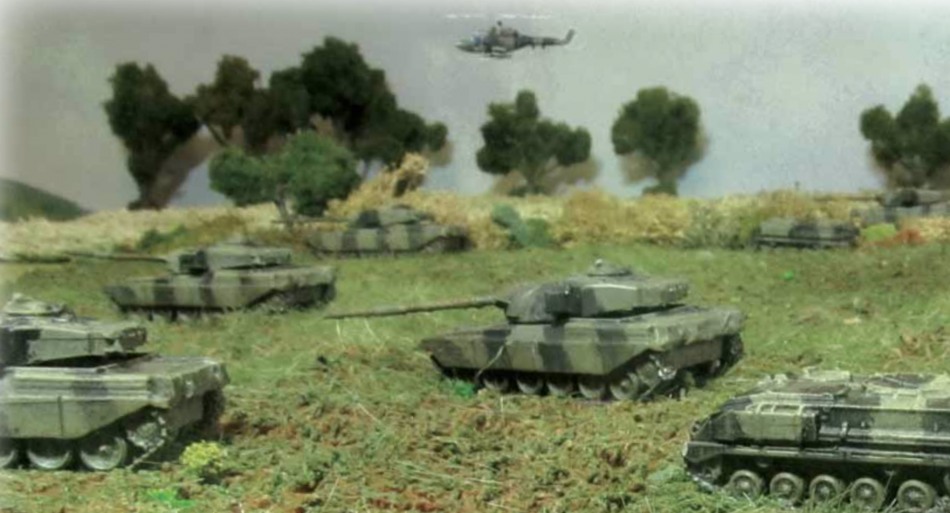Battlegroup NorthAG – A mighty fine new set of rules for WWIII
By Tom Gall and NDNG Dane
 The (PSC) will be releasing shortly* a much anticipated new set of rules covering World War III, while a “what if”, a conventional war has touched off and the forces of NATO and WARPAC are enjoined in battle across Europe, each in a desperate struggle to take/give ground before presumably, the nukes might fly.
The (PSC) will be releasing shortly* a much anticipated new set of rules covering World War III, while a “what if”, a conventional war has touched off and the forces of NATO and WARPAC are enjoined in battle across Europe, each in a desperate struggle to take/give ground before presumably, the nukes might fly.
Titled Battlegroup: NORTHAG, the book focuses on the Northern Army Group section of the front, thus NORTHAG. The setting is 1983 which Warwick Kinrade choose as it was a time of heightened tensions between the powers and was the dividing line before the introduction of a wide range of new equipment.
In this series of articles, we’ll be looking at the rules, the British and Soviet army lists that are included with the new book and finish up with a couple of BatReps.
Basic Principles
Scale / Figures
PSC has a line of 10mm figures that go with the game. While I don’t have any in hand, PSC has an excellent reputation for making kit. Within my own 15mm collection, I have numerous examples of PSC hardware which, when assembled, had a great set of options for representing vehicle variants. While the NORTHAG miniatures are sight unseen to me, I’m sure they’re going to be great.
Why play in 10mm? Picking a scale is up to an individual gamer. If everyone has 10mm, why not fit in? If you are already vested in 15mm, no worries, go with that. If 6mm (1/285) is what you love, go for it. The rules do not make a critical requirement of one scale over another.
The advantage of smaller scales like 10mm is that you can represent a larger battlefield. Vehicles and infantry are then, in turn, more spread out and that also will challenge you to use better tactics. Games with vehicles all-wheel hub to wheel hub just look bad.
Infantry in NORTHAG at the most basic level is comprised of teams. Teams number in 4, 3 or 2 depending on the purpose of the soldiers in question. The state that matters most when it comes to infantry teams in the game is are they combat effective or not. Teams that are not effective are removed from the game. You don’t keep track of individual casualties that might affect a team.
If you play Team Yankee, you’re probably wondering if you can reuse your 15mm collection, the answer is yes. Not only will your vehicles fit in, but your infantry stands will as well. What you’ll find is you’ll be inspired to add vehicles and weapon systems that aren’t in Team Yankee. The heavy weapons stands on large bases will be the only element that might be a little out of place, but regardless they are workable.
Battlegroup
Are you familiar with ? If so you’ll recognize a number of game mechanics in NORTHAG. If the 1980s and Cold War era is attractive to you as a Battlegroup player, then NORTHAG is definitely going to feel like a very comfortable shoe with a number of differences I suspect you’ll welcome.
Lists
NORTHAG offers the type of gaming where you and your opponent can agree to a point value, and show up at the table for a game. The more points, and thus more units you field, the larger the recommended table size for the action.
This is not a tournament game. Instead, it is a more historical experience, not quite a simulation but still a fun time. The lists offer the range of hardware that the nations in question had in the field. NORTHAG has both the British and Soviet armies covered in the book with the promise of more lists coming soon.
The lists in the book guide you as far as what minimums and maximums you can field. The lists contain a wide variety of hardware which is probably going to make you feel like a kid in a candy store. Consider Soviet tanks, you’ll find the T62K, T-64A, T-64B, T-64AK, T80s, T-80B, and T-80K. NORTHAG includes weapon systems that other rules don’t include like mortars and towed guns. This brings a huge amount of flavor to your tabletop.
The Turn
NORTHAG is a you-go-I-go system. Core to the turn is the concept of an order. When it is your turn you’ll have a certain number of orders you can execute across all your units. Each unit can only perform one order. Top of your turn you can either take the default number of orders which is a function of the game size and if you are WARPAC or NATO or chance it to the dice plus the number of officers you have. Feeling lucky punk?
As you issue and execute your orders you can be potentially interrupted by your opponent should they happen to have a unit that was issued an Ambush Fire order and that unit is not pinned down. Ambush fire allows them to interrupt any order at any time and fire. This game mechanic is a powerful one and great to see.
Orders that you may give to your units include Maneuver and Fire or Fire and Maneuver, Top speed, Fire!, Open Fire with Anti Tank, Embark / Disembark, Limber / Unlimber, Infantry Close Assault, Request Indirect Fire, Engineer, Repair, Recover, Ambush Fire and if you’re NATO, Tactical Coordination. Mass orders to a company (if WARPAC) or platoon (if NATO) can also be given costing multiple orders but also being more efficient.
I won’t cover all the orders, as most as are just like they sound. Importantly if a unit is pinned you can’t issue an order to it. To unpin a unit, at the very end of your turn you have the option to Rally which takes a counter (more about these in a moment), roll a D6 and unpin that number of units.
A standard move for infantry is 4″ and vehicles, depending on type, will move as slow as 4″ offroad to as much as 20″ on road. A top speed order is a double move.
Once you are out of orders, your opponent now determines how many orders they have and performs the same process or issuing orders to their units one by one. This system can result in some of your units sitting still effectively doing nothing. This makes you concentrate on the important parts of the battlefield.
Morale and Battle Rating
I mentioned the counters a few moments ago. When you assemble a force, each unit in your force has an experience level and a battle rating. All of the battle rating values from all your units are summed together.
The battle rating system has you draw a counter from a shared pot/bag/whatever as units are eliminated or no longer combat effective. When you draw a counter, you keep it secret from your opponent, it probably will have a value on it that you subtract from your battle rating that goes with your force. Once your battle rating is less than the value of all the counters you’ve drawn, your force will withdraw from the field, game over. Not all counters go against your battle rating, some grant you special events.
This is a wonderfully designed game mechanic that will keep your opponent guessing as far as just how close their side is to buckling. The master sheet of counters is found at the end of the book. I’m sure you’ll be like me and be seeking a set in wood/resin or some other material.
Besides the battle rating system I’ve mentioned, each unit is either pinned or unpinned. Units that are not pinned may be issued orders and are fully combat effective. A pin happens when a team takes fire, is successfully hit, and fails its cover save. If the unit is already pinned, it needs to take a unit experience test to determine if it will stick around on top of the usual other rolls.
Pinned units are keeping their heads down and will not take orders. NATO has a special Tactical Coordination order which for the price of drawing one counter and consuming one order allows you to unpin D3 units during the phase of the turn when you are issuing orders. Forward Boys!
Generally, your only way to unpin a unit is at the end of your turn during the rally step. If you take a counter you’re able to unpin D6 units. You can take more counters to roll more dice to unpin more units. Of course, when it gets close to the end of the game and you’ve taken plenty of counters already, you have to start asking yourself just how badly do you need that unit?
There are other in-game events that might cause you to take a counter besides losing a unit. The first time you suffer an air attack by strike aircraft you draw a counter. If the enemy takes an objective you will have to draw anywhere between 1 to 3 counters depending on the location of the objective. If they take an objective in your deployment zone, for instance, that’s 3 counters!
Combat
Violence in a wargame? Let’s talk about shooting at each other and how it works in NORTHAG. It is a D6 based game. Many elements of firing is a function of range, line of sight and what type of weapon system you are using.
NORTHAG has several modes of combat depending on the weapon system or unit doing the fire. Suppressive / Small Arms is from generally involves infantry. Direct Fire comes in the form of either High Explosive or Armor Piercing and is usually an AVF, or towed gun firing. Anti Tank missiles is another form of fire either wire guided or laser guided depending on the device firing. Last is indirect fire which is your traditional towed artillery, or mortars firing indirectly at a map grid under the guidance of an observer.
This section touches are these various forms of fire and the process used.
Suppressive Fire / Small Arms
Assault rifles, Machine guns and so on fall into the category of small arms. With NORTHAG all small arms fire is suppressing fire, where you look at the range and your rate of fire to determine if you are successful. HE fired by field guns or akin can also be suppressive fire.
If the roll is is successful, the target rolls a cover save on a D6. Out in the open, they need a 6, from the comforts of a fox hole, a 3+. If the target fails the roll they are pinned.
Infantry that fails its cover save then goes on to make a roll on the casualty table. A failure here means that the team has gone combat ineffective and is removed from play. Draw a counter against your battle rating! Typical fire from small arms is looking for a 2+ to avoid any casualties. If the infantry team has been targeted by a medium HE shell, it’ll be a 4+ that they need.
Direct Fire / Anti-tank Missiles
The next type of fire is aimed fire with high explosives or armor-piercing shells. If you’re familiar with the WWII version of battlegroup you might be wondering if there is aimed small arms fire. There isn’t. It’s all streamlined under suppressive fire. (It’s a nice improvement!)
With aimed fire HE attacks, first you roll to see the target using a D6. Modifiers exist for smoke, obscurity, advanced sights and so on. If you pass, next you roll a D6 to hit which is a function of the range with application of modifiers such as if the target or firer was moving, 40″ + starts out at a 6 for instance, next a cover save is made if the target is a soft skin vehicle and it fails the cover save it is destroyed, if it is a deployed gun same process make a cover save or be destroyed, and against armored vehicles, they utilize the same process as AP fire.
Aimed Fire involving AP is similar to HE fire. A roll to see the target with modifiers, the same as HE fire, followed by a roll to hit, with modifiers again the same as HE. But, instead of a cover save, the armor penetration table is used. Guns that fire AP are rated 1 to 10 and the value is a function of range, and armor values for a target are likewise rated 0 to 10 for front, side and rear. The firer rolls 2D6 and compares the result to what it is in the table, a roll less then the needed value only causes a morale check, an equal value a pinned result and great the vehicle is destroyed.
The last kind of shooting is aimed fire with anti-tank guided missiles. The process is exactly the same as HE/AP fire, roll to see, roll to hit, armor penetration vs armor rolling 2D6 and then consult the table for results.
Across the various vehicle types and weapon systems are key words associated which grant some of them improved sighting capabilities, improved gunnery and so on. What I’ve outlined above is bog-standard mechanics. As you’d expect a British Chieftain MK9 has both advanced sighting and gunnery granted via keywords that map to special rules.
Artillery
Given the range of artillery, these assets are generally going to be off-board in NORTHAG. With ranges, in-game attempting to be reasonably accurate, most fire missions you’re calling are effectively danger close compared to what a real soldier in the field would be facing. It is just a game and artillery is an important component.
To call in artillery you have included with your list, you first utilize a Request Indirect Fire order. This order can only be issued to a Mortar spotter or Artillery spotter.
Next you make a communications test which is a D6 looking for a 3+. Are they there? Are they listening? Hello? Hello? Sergent, did you check the batteries?
Presuming you’re successful, now you position a spotting round marker on the table within 70″ and line of sight of the soldier making the request. Then you roll a die for deviation, which will result in anywhere from a 1D6″ – 4D6″ in a random direction. If you’re happy with the result, now you issue a Fire for Effect order to the battery conducting the mission.
You tally up the number of tubes firing and roll that many D6 on the accuracy table. The number of direct hit results are then allocated to starting with the closest unit within 10″ of the spotter round. Then you do the same with pin results starting with the closest unit within 10″ and working your way out. No templates needed!
Hits are resolved the same process as direct fire HE and pinning hits are resolved the same as taking a hit from suppressive HE fire. Armor penetration saves are made against the side armor, cover saves and casualty checks are still made which means an infantry stand taking a pin result could still be removed from the game.
Summary
Thus far we’ve looked at most of but not all the core rules. I’ve left out airpower, special rules, and engineering which we’ll get to in another article. We’ll also be looking at the lists and list building for NATO (British) and Warsaw Pact (Soviet) that are included with the book in a follow-on article.
I think these rules warrant a strong buy recommendation. Battlegroup: NORTHAG builds on the well designed Battlegroup series but for WWIII. The system evolves a good set of mechanics and delivers on a modern flavor. Battlegroup has produced numerous add on books for their WWII series and I have great faith that we’ll see more lists, and more add on volumes for this era.
I do look forward to the PSC models that are coming, 10mm will be tempting, tho I also hope they’ll make 15mm versions as well which would result in instant-buys for the numerous piece of hardware found in the rules that no one else makes.
Last, thanks to Dane Tkacs for his help and contribution to this story. Thanks to Piers Brand and PSC for granting us early access to the rules.
* shortly in the case is a bit fluid given the global situation. The rulebook is at the printers in the UK. Watch either the PSC website, the PSC facebook page or Battlegroup NORTHAG page for updates.




Great overview. I’ll definately buy the rules, when available. I unfortunately missed the preorder.
a bit strange that there is so little on their website about this. id love to preorder a copy of the rulebook but there doesnt appear to be any avenue to do this currently.
May 3rd is the release date. It’s official!
Now the question is how will that work world wide given the current situation? Good question. Probably will be easier to get if you’re in the UK.
This sounds like one of those fantasy WW3 games I played as a young gamer in the 70s/80s. Artillery has a wild deviation and then you can fire for effect if you like it? That NEVER happens in real life. That’s just the kind of random dice rolling that gamers like.
Given the strange choice of 1983 when the Soviets were at the peak of their technology for that era but before NATO had brought on their equivalent M-1/ Bradley/ Challengers, it sounds very one sided.
Yes the artillery mechanic from Battlegroup is in use. I certainly prefer it over Team Yankee with no deviation at all, ever.
Challengers are in the game. Americans are not in NorthAG so too early to tell what American lists might look like unless of course you design your own.
Fantasy? Well we are playing with little plastic/metal miniatures 🙂